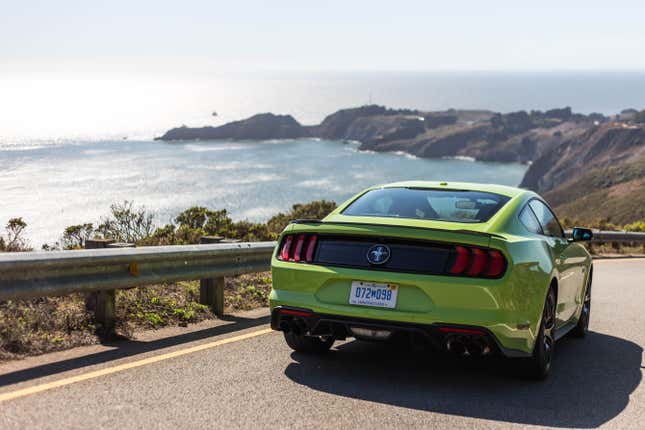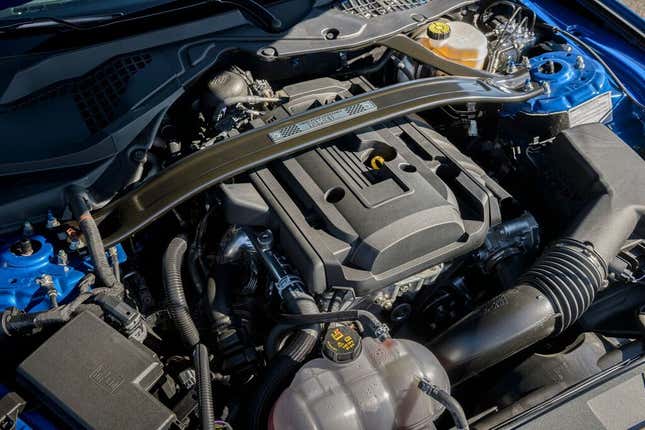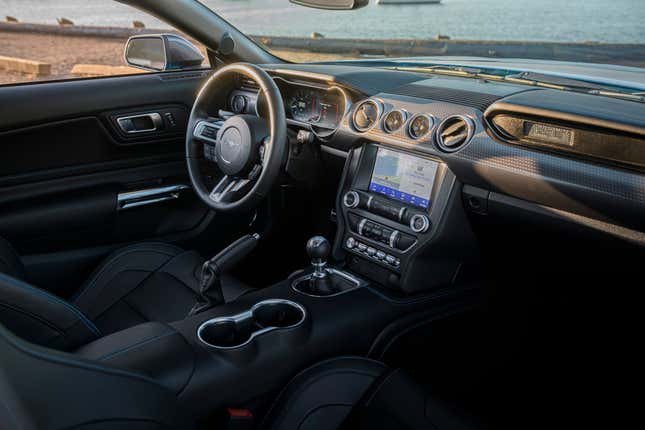The 2020 Ford Mustang EcoBoost High Performance Package is what happens when you drop the engine from a Focus RS into the body of a grand tourer. The exterior dimensions don’t change, but damn do they feel like they did. It’s amazing what a lightened nose and some good rubber will do.
The game of making cars better performers can be played in a variety of ways, but my favorite method by far is simply cutting weight. This is what the HPP EcoBoost Mustang does, and after the two or so hours I spent behind the wheel, I can say I’m walking away from a winner.
(Full Disclosure: Ford flew me to San Francisco to drive the new EcoBoost HPP Mustang. It put me up in a very nice hotel, fed me a lot of delicious food and provided all the gas.)
Anyone who says the EcoBoost Mustang HPP “isn’t a real Mustang” without driving it first is seriously depriving themselves.

What Is It?
The HPP EcoBoost Mustang started out as a Focus RS engine swap skunkworks project that eventually made it to production. So, no, it doesn’t have the four-banger from the regular EcoBoost Mustang. Rather, it uses the high revving motor that’s built in Valencia, Spain.
The High Performance Package is an option you can get on all Mustang EcoBoost models (coupe or convertible, manual or automatic) for $4,995. It’s the performance four-cylinder alternative to the classic, V8 Mustang. And it’s poised as the more affordable option; Ford estimates it to get 23 mpg in combined highway and city driving and you might be able to save a little on insurance because it’s not as powerful as the V8.
Spiritually, it’s the new Ford Mustang SVO. Why it’s not called that probably all comes down to branding–Ford’s performance arm is simply called Ford Performance now.
Specs That Matter
From the turbocharged, 2.3-liter engine comes a claimed 332 horsepower and 350 lb-ft of torque, up about 20 horsepower from the standard EcoBoost model. Ford says the turbocharger has been increased in size by about five percent to include a 63-millimeter, twin-scroll turbo compressor and there’s a bigger radiator. Ford claims the turbo now produces 22 pounds of boost and makes peak torque past 4,000 rpm.
In addition to the engine, the HPP also gets bigger front brakes from the Mustang GT, an alloy strut tower brace, a 32-millimeter sway bar up front, and a 21.7-millimeter bar at the back. There is also a bigger front splitter and brake cooling ramps. The weight distribution is now 53/47, according to Ford. The base, automatic GT’s is 54.8/45.2, 54.2/45.8 for the manual.
Finally, there is also an optional handling package, which gives you MagneRide dampers and a Torsen limited-slip rear axle. You’ll also get a 24-millimeter solid rear sway bar and a set of Pirelli P Zero Corsa4 summer tires.
What’s Great

I went into this drive expecting to feel a significantly lighter nose than the Mustang GT’s, and I was not disappointed. The HPP EcoBoost Mustang loses four whole cylinders over its larger, V8 brethren and the sensation hits you like a splash of cold water. I never thought the steering in the V8 Mustang was ever bad, but sometimes you just can’t beat good, old physics.
The Mustang I got to take out was equipped with the handling package, and the difference in steering feel was apparent in the very first corner. The car responded to the lightest touch, and even though the steering was much, much lighter, it wasn’t vague. It still communicated the road up through my fingers, and for the first time behind the wheel of a Mustang, I didn’t feel like I was driving with a giant weight balanced over my knees. It was spirited, it was quick, it was alert—it was fun.
It felt very European, actually. Like a proper European sports car. Light, petite and agile. An engine that won’t outrun the chassis. Steering that tells you exactly what the nose is doing. The Mustang is not a small vehicle, and the roads Ford chose to let us drive on were not large, but the lightened up steering shrank the car and expanded the roads around us.

I’m not ignoring the fact that we were riding on tires that could easily handle a car with at least 150 more horsepower. The Pirellis staunchly refused to unstick from the road, an experience that built up an incredible amount of confidence. This HPP EcoBoost Mustang, with the handling package, is an autocross all-star waiting to happen.
A Ford spokesperson told us the car’s maximum lateral grip (with the handling package) is over one G, and that the HPP saves 200 pounds off the nose over the V8. That’s significant.
Previous complaints note the EcoBoost Mustang tended to run out of juice near the top of its rev range. The HPP keeps the power very linear, not peaky. It pulls nicely to its 6,500-rpm redline. The 10-speed automatic, though no dual-clutch, shifts snappily enough, though I’d recommend getting the six-speed manual, obviously.
Later on, I went out in a car without the handling package and immediately noticed the absence of those heroic tires. Don’t get me wrong, everything was still extremely fun and communicative, but I just didn’t have the same confidence to push it as far as I did earlier.

Put it this way: Both versions are perfectly great at spirited driving on some fun back roads. But if you really want to explore the limits and stick the corners at your local autocross event, you might want to spring for that handling package. It makes the Mustang feel like a whole different car.
What’s Weak
It’s clear that Ford has done a lot of work to make the exhaust sound sporty and cool, but it still does sound like a four-cylinder. Maybe you like what they sound like, but I found the noise a bit droney after a while. It quiets down very nicely in the low revs, though. And the whooshes the turbo makes are neat.
Then we get to the price. Once you’ve stocked up your HPP EcoBoost Mustang with all the goodies, it gets expensive. Our loaner, with the handling package ($1,995) came out to $42,070 because it was basically fully loaded.
And while the handling package is a good deal by itself, you can’t just get it alone. It must include the $2,000 101A Equipment Group, which offers a fancy stereo system and selectable drive modes. In all, the option really comes out to $3,995.
I don’t make the rules, sorry.
Early Verdict
Yes, you can option out your HPP EcoBoost Mustang to cost as much as the V8 version. But it all comes down to your driving style. Either you’re OK with four-cylinder noises but love great handling for precise, spirited drives, or you just want the V8 for the power, the sound and donuts.
On paper, an extra 20 horsepower doesn’t sound like a whole lot, but you also have to consider it’s an entirely different engine and a bunch of other performance bits to boot. On a twisty, technical course, I have no doubt the HPP EcoBoost with the handling package will outshine the base V8. But the V8 will still run away on the power circuits.
Really, the biggest problem I can see with the HPP EcoBoost Mustang is the V8 Mustang exists. It’ll never live down that comparison, though it should.